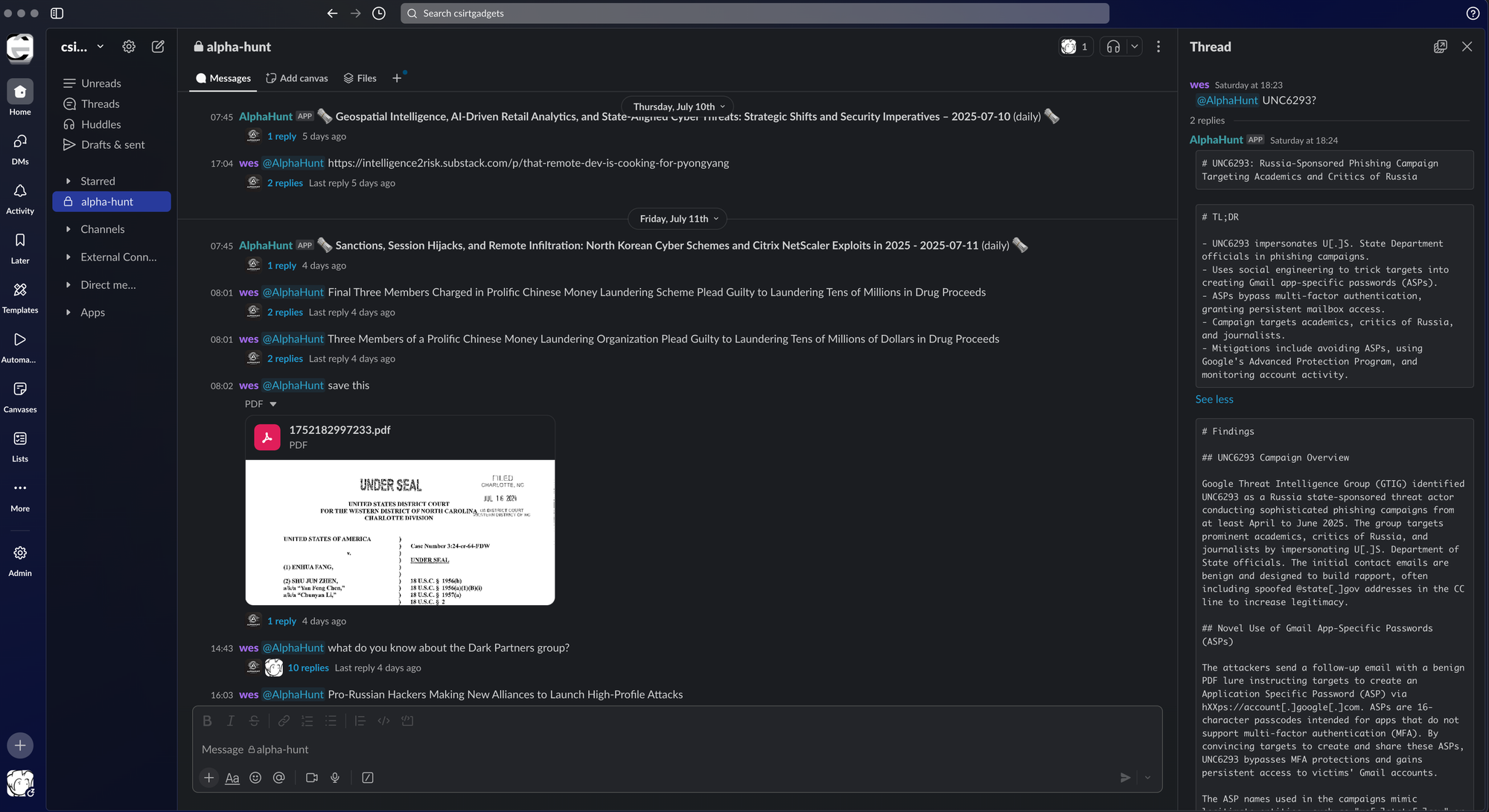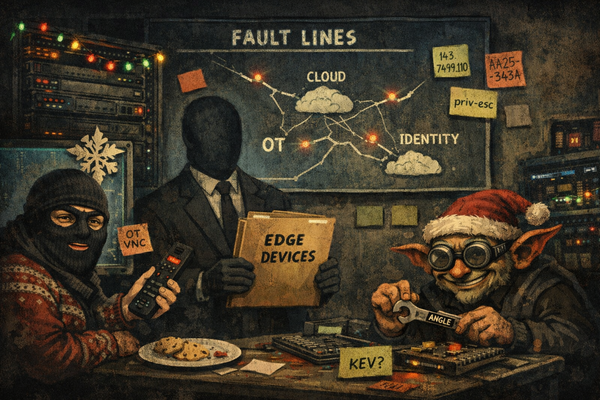Q4 2025 Threat Priorities: Ransomware Surge, Regulatory Volatility, and Geopolitical Disruption in US Tech, Finance, and Education
Three converging trends—ransomware, volatile regulations, and global instability—are reshaping risk for US tech, finance, and education. The common thread? Disruption spreads faster than most organizations can detect or respond.

(Have feedback? Did something resonate with you? Did something annoy you? Just hit reply! :))
Want to show off your forward thinking skills with your boss?
write a report on the top 3 PIRs US technology, finance and education organizations should be prioritizing heading into Q4 of 2025.
Start being proactive, rather than reactive.
This baseline report was thoughtfully researched and took 15 minutes.. It's meant to be a rough draft for you to enhance with the unique insights that make you an invaluable analyst.
We just did the initial grunt work..
Are you ready to level up your skillset? Get Started Here!
Did this help you? Forward it to a friend!
TL;DR
Key Points
-
Tighten cross-sector intel sharing: Ransomware incidents in education/finance up 23% YoY.
-
Automate compliance monitoring: New AI, digital asset, and privacy rules demand faster adaptation.
-
Diversify supply chains & talent sources: Geopolitical instability threatens continuity.
Why it matters
-
SOC: Prioritize detection for ransomware pre-positioning, valid account use, and supply chain anomalies.
-
IR: Preserve forensic artifacts on initial access and supply chain entry points; capture full network/endpoint telemetry.
-
SecOps: Enforce MFA, restrict third-party code signing, and validate backup restoration processes.
-
Strategic: Invest in geopolitical risk monitoring, formalize cross-sector intel MOUs, and fast-track compliance automation.
The story in 60 seconds
State-sponsored (China, Russia, Iran) and criminal ransomware crews are accelerating attacks against tech, finance, and education. Education saw a 23% YoY spike—many breaches leveraging valid accounts and supplier compromise.
Meanwhile, US regulatory priorities for AI, digital assets, and data governance are shifting rapidly. Organizations failing to operationalize compliance risk penalties and disruption.
Overlay global tensions—trade disputes, sanctions, and talent restrictions—and you have a cascading risk environment where one disruption can ripple across sectors within days.
See it in your telemetry
-
Mail: Phishing with sector-specific lures (university portals, bank login pages).
-
Endpoint: Unexpected encryption processes, unsigned binaries from vendor update channels.
-
Network: Lateral SMB traffic post-initial access, outbound C2 to uncommon TLDs.
Quick wins
- Push new IOC sets from FS-ISAC and K12SIX into SIEM.
- Audit vendor access logs for anomalous activity.
- Stand up automated monitoring for AI/digital asset regulatory updates.
Suggested Pivots
- Which supply chain .. (UPGRADE TO FIND OUT!) .. in place?
- Can your SIEM .. (UPGRADE TO FIND OUT!) .. within 2 minutes?
- What’s the maximum .. (UPGRADE TO FIND OUT!) .. can survive without primary suppliers?
What to watch out for
- Surge in .. (UPGRADE TO FIND OUT!) .. or phishing attacks targeting university portals or regional bank online services, signaling pre-positioning by ransomware groups.
- Increased volume of .. (UPGRADE TO FIND OUT!) .. and cross-sector incident response exercise participation metrics.
- Federal or state regulatory .. (UPGRADE TO FIND OUT!) .. or digital asset custody requirements.
- Reports of .. (UPGRADE TO FIND OUT!) .. component shortages linked to geopolitical events or trade policy changes.
Ready to level up your intelligence game?
Strategic Summary
US technology, finance, and education sectors face a surge in disruptive cyber threats, notably ransomware and supply chain compromises, driven by state-sponsored actors (China, Russia, Iran) and sophisticated criminal groups. The interconnectedness of these sectors amplifies systemic risk, with education and finance among the most targeted for critical infrastructure attacks.
Simultaneously, regulatory volatility—especially around digital assets, AI, and data privacy—demands rapid adaptation to shifting compliance obligations. Organizations must proactively monitor and operationalize new federal and state requirements to mitigate legal and operational exposure.
Geopolitical instability is further compounding risk, with trade tensions and policy shifts causing supply chain disruptions and restricting talent mobility. Strategic intelligence and scenario planning are essential to maintain resilience and competitive advantage.
Recommended actions include strengthening intelligence sharing and incident response, automating compliance aligned with NIST/ISO standards, and deploying robust geopolitical risk monitoring and continuity planning. Metrics for success focus on IOC sharing, response times, compliance audit outcomes, and supply chain/talent continuity.
Short-term forecasts anticipate intensified ransomware campaigns (Black Basta, Wizard Spider), increased IOC sharing, regulatory enforcement on AI/data privacy, and supply chain volatility. Long-term, adversaries are expected to adopt AI-driven evasion, regulatory frameworks will fragment, and organizations will need to invest in integrated risk management and cross-sector coordination to withstand cascading threats.
Top Three Priority Intelligence Requirements (PIRs) for US Technology, Finance, and Education Sectors – Q4 2025
1. Resilience Against State-Sponsored and Criminal Cyber Threats to Critical Infrastructure
Description:
US technology, finance, and education sectors are experiencing a surge in disruptive cyberattacks, particularly ransomware, from both state-sponsored actors (notably China, Russia, and Iran) and sophisticated criminal groups. These attacks increasingly target critical infrastructure, with education and finance among the most affected, and leverage advanced techniques such as pre-positioning on networks, supply chain compromise, and extortion.
Relevance:
A successful attack on any sector’s critical infrastructure can have systemic effects, disrupting essential services, eroding public trust, and causing significant financial and reputational damage. The interconnectedness of technology, finance, and education means vulnerabilities in one sector can propagate to others, making cross-sector resilience a strategic imperative.
Supporting Evidence:
-
“Ransomware attacks against schools, colleges and universities rose 23% year over year in the first half of 2025, according to a report from Comparitech. Education was the fourth-most-targeted sector during the first half of 2025, behind business, government and healthcare.”
(K-12 Dive, July 2025) -
“Every day, lone hackers, organized gangs, and nation-state threat actors challenge the operational resilience of the financial services sector. Powerful new tools enable more effective fraud, ransomware, supply chain, and DDoS attacks, among other threats. Emerging technologies, geopolitically-motivated cyber activity, and new regulation complicate an already complex operational environment.”
(FS-ISAC, Navigating Cyber 2025)
2. Navigating Regulatory Volatility: Digital Assets, AI, and Data Governance
Description:
Rapid regulatory changes in digital assets, artificial intelligence, and data privacy are reshaping compliance obligations and operational risk for US organizations. The new federal administration has prioritized regulatory clarity for digital assets and AI, with significant shifts in policy, leadership, and enforcement. Education, finance, and technology organizations must adapt to evolving standards for digital asset custody, AI integration, and data protection, while managing uncertainty around future federal and state actions.
Relevance:
All three sectors are deeply impacted by digital transformation and the regulatory frameworks that govern it. Uncertainty or misalignment in compliance can result in legal exposure, operational disruption, and loss of competitive advantage. Proactive intelligence on regulatory trends is essential for strategic planning, investment, and risk management.
Supporting Evidence:
-
“The new administration has taken several steps to bring the US more in line with other jurisdictions that have embraced the potential for responsible innovation of digital assets through the establishment of clear regulatory frameworks... providing regulatory and legislative clarity for digital asset activities is now a priority.”
(State Street, 2025 Regulatory Preview) -
“Challenges include limited resources, cybersecurity and data privacy requirements, poor data management and governance, institutional culture, and the need to restore trust in higher education’s use of technology and data.”
(EDUCAUSE, 2025 Top 10 IT Issues)
3. Geopolitical Disruption to Supply Chains, Markets, and Talent Flows
Description:
Geopolitical tensions—especially US-China competition, Russia-NATO conflict, and instability in the Middle East—are driving volatility in global supply chains, financial markets, and cross-border talent flows. These disruptions threaten the availability of critical technology components, financial stability, and the ability of educational institutions to attract and retain international students and researchers. The risk of sudden regulatory, trade, or security policy shifts remains high.
Relevance:
Technology, finance, and education are all globalized and interdependent. Disruptions in supply chains or market access can halt operations, while restrictions on talent mobility undermine innovation and competitiveness. Strategic intelligence on geopolitical risk is vital for scenario planning and business continuity.
Supporting Evidence:
-
“Politically related disruptions are an ongoing reality in global trade, and events this year have certainly borne that out—most prominently in many of the new U.S. president’s actions and proposals. And we can expect more disruption.”
(Thomson Reuters, 2025’s Supply Chain Challenge) -
“The findings come as Trump's tariff policies raise fears of renewed trade friction, posing risks of strained operations, higher costs and supply chain delays for U.S. businesses.”
(Reuters, June 2025)
Recommendations, Actions, Suggested Pivots, Forecasts and Next Steps
(Subscribers Only)



![[DEEP RESEARCH] Zero-Days Are a Distraction: 2025’s Biggest Losses Were Stolen Tokens + OAuth](/content/images/size/w600/2025/12/zz-3.png)


